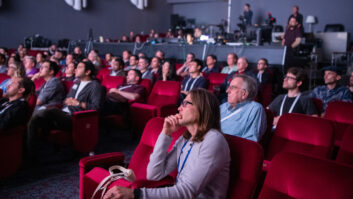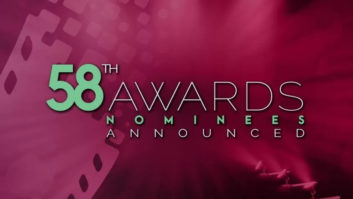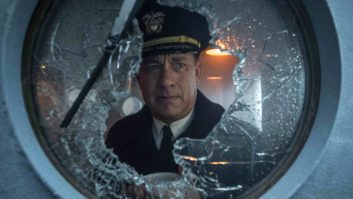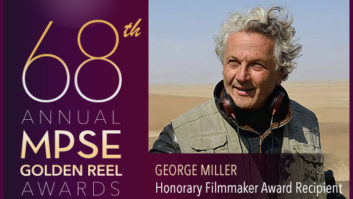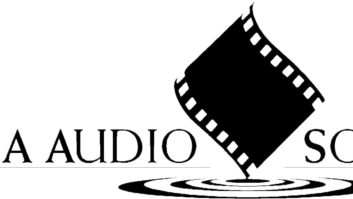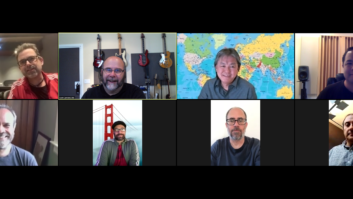He is arguably the finest film sound mixer of his generation, with a credit list that stretches across five pages on www.imdb.com and runs the gamut from action to comedy to suspense to rockumentary to drama and everything in between. Last March, after 30 years behind the board, Mike Minkler took home his first Academy Award, for a stunning mix on Black Hawk Down.
But so many of his films over the years have been Oscar-worthy: China Syndrome, Altered States, Tron, Born on the Fourth of July, JFK, True Lies… the list just keeps going. One word you might hear to describe his mixes is “tasty.” In his own words, Minkler modestly says that he just knows when sounds “fit.”
You could say that Minkler was born to mix films. Certainly, the genes all but demanded it. His grandfather began developing disc recorders back at Chicago Labs in 1928, then came to Hollywood soon after to work on the Vitaphone project at Warner Bros. He later built a company called Radio Recorders; today, we know the site as the Record Plant.
His father, Don Minkler, began in the late ’40s and went on to found a company called Producers Sound Service. His uncle, Bob Minkler, won an Oscar for a little film called Star Wars. Minkler’s son Christian is an Emmy-winning mixer, graduating from TV to feature films (Natural Born Killers, The Farm). Four generations. Nepotism? Sure. But that will only get you so far in a town where you’re only as good as your last job.
Minkler started mixing full-time in 1974 at the age of 22, jumping at whatever work presented itself — TV, trailers, commercials, small features, anything he could get his hands on. He admits that it was not easy breaking in. “Directors would walk in and see me at the console, and they’d say, ‘I’m not giving my tracks to this kid,’” he recalls. “I had a really rough couple of years.”
It’s not as if Minkler has been without controversy over the years. He’s outspoken, he’s passionate; to some, he may even be difficult to work with. But every Minkler story ends with an absolute respect for his talent and dedication. His commitment is to each and every film in the broadest sense — a dedication to sound as an emotional linchpin in the art of storytelling. He does not compromise, but now, at the age of 50, he has certainly mellowed. He seems to be right where he wants to be.
We pick up the Minkler story in early 1976 when he got his break, a really big break. In classic Hollywood fashion, it all began with a phone call…
After years of hard work, you’re at the right place, the right time.
I was in my dad’s office, and he’s on the phone to Al Green over at Warner Bros. Al is looking for a replacement for two weeks on a feature. I was listening to my dad go down his list of mixers, going, “No, he’s not available…” and I’m standing there saying, “Dad! Dad! Dad!” He finally says, “The only one left is my son Mike. He’s kinda new, but if you want to give him a shot.” I raced home, got on my fancy clothes and went over to meet Al Green. He didn’t even look at me, but he walks me over to the stage and he introduces me to Arthur Piantadosi, the lead mixer on stage 5. Arthur looked at me and says, “We’re going to lunch. Be back in an hour,” in this very intimidating voice. So they leave me sitting there by myself for an hour, and then I had to audition for the rest of the afternoon. They were doing M&Es on All the President’s Men. Les Fresholtz and Arthur. They were just about to win the Oscar for that.
So I spent the rest of the afternoon taking these one or two footstep tracks and working on this M&E, trying to do an audition. They wrapped at about 6 o’clock, and I said, “So, do you want me to come in on Monday?” Art said, “Well, did anybody tell you not to?” So I showed up Monday. Dubbing 5 was the big room, the big feature room, so it was a tremendous break for me to work with Art and Les. They were my mentors, and I owe a lot to them because they brought a sense of cinema. I couldn’t have gotten anything better from anyone else. We had four years together.
What was the board back then?
An award-winning Quad Eight, their biggest one to date. The first to have…well, it actually had 24 mix buses on it, but it looked like it only had eight. In 1975, we got The Grateful Dead Movie, an experimental art film with a 5-channel quadraphonic mix. They were very technical people. They went into the schematic of the board and figured out that we actually had 24 mix buses. We could split this thing out. We could do all kinds of panning, with all kinds of separation, if we would just rethink what we were doing. I was in awe of what these guys were doing with signal processing, just watching [Grateful Dead sound mixer] Dan Healy manipulate audio. So I took what I learned from them, and our next picture was Star Wars. I wanted to do things that everybody said I couldn’t do, that hadn’t been done before — the simplest things, like insert recording in stereo. If we can do it in mono, why can’t we just do it in stereo? They said we can’t do that. Well, sure we can. Watch. [Laughs] I hit the button. Then I wanted to pan something to the surrounds at the same time I was recording in the front. They said, “You can’t do that; the surrounds are always done in a separate pass.” I said, “What do you mean?” and I did it. From that day on, we did all of our 4-track and 6-track recordings using surround panning in the same pass.
Les, Art and I premixed Star Wars, but due to a commitment to go on to another film…[long pause]. We put together a team of Bob Minkler, Ray West and Don Macdougal working nights over at Warner Hollywood, then called Goldwyn.
A lot of work in the predub…
It was wild. Ben Burtt and Sam Shaw had come up with all these great sounds. The visual effects were not finished yet, so we were premixing the battle scenes to WWII footage, with bombers representing X-wing fighters and fighter planes representing Tai fighters. It wasn’t until the cast and crew at the Academy Theatre, about a week before the premiere, that anyone had seen the finished picture, including George. Their print was so wet, so new. Even the end credits looked like they were scribbled on. When that screening started, with the first overhead pass-by, people were screaming and yelling, and it went that way for the whole movie. When it was over, it was a 10-minute standing ovation, just hooting and hollering. At that moment, everyone thought, this is it.
Do you agree with what some say, that it changed film sound?
Absolutely. A hundred percent. It was a defining moment because of Dolby Stereo. At the same time, it was the birth of baby boom. The 6-track was devised by Steve Katz, who was the Dolby consultant on the show. When we were predubbing reel 1 spaceships, we couldn’t get this big thunderous low end that we wanted on the pass-by. We were going to do what we called a “Todd spread” back then, which was to record a left, center and right, and a surround — then fill in channels 2 and 4, the left extra and right extra, with information from these adjacent channels. But Steve said, “What if we used 2 and 4 for boom only, the low-frequency information, and we’ll use full-range speakers.” Well, we didn’t have them; we had the Altec A4 speakers, and we put low-frequency material in there as much as we could to enhance the spaceships. And every time there was an explosion, there was a sweetener that was cut for those two channels. Years later, it switched again when Apocalypse came along, where the two channels were used for left and right surround, and 6 was used for the boom. That was the Walter Murch idea: Why waste two channels for boom? He also had the advantage of low-frequency speakers. Anyway, Star Wars was the first baby boom, and it worked.
It was also the first time that there were 300 tracks per reel. Prior to that, the most I had ever seen was around 25. So there was the necessity of making great predubs, because there was no way you could go in and hang them and start over again with something like that. Now it also had the advantage of the Dolby A-type noise reduction. No way could we play that many predubs and original units without Dolby noise reduction. The hiss level would have been enormous. As it was, it was still bad. [Laughs] Everything was a little cruder back then.
Walter Murch recently wrote in an essay that we have all these amazing tools at our disposal now, so it’s time to go back and revisit the
art
of film mixing.
I agree, and certainly on the Apocalypse side. The success of that soundtrack is its art. Technically, it’s not astounding. It was 1978, and that’s what they had to use. The beauty of that film is its art; it doesn’t get any better. I recently redid The Exorcist from scratch — the only thing we used was the dialog mono channel. But when I had my hands on that original masterful mix, technically it was a piece of junk. There were more snaps and pops and bad this and bad that. God it was horrible. But artistically, it’s a perfect mix for that movie. Apocalypse is the perfect mix. They don’t get any better than those two movies.
There has always been this interplay between technology and art. How have technical advances of the past 25 years changed the way you work?
On a technical level, we had to be very aware of phase shift, all the way through the chain — the machines, the recorders, the consoles. If you had bad-quality tracks, it really showed up in this new world of the x-curve and multiple speakers. Before, we had the mono Academy roll-off, which actually could hide all of the imperfections in the sound. The leap from the mono world to the Dolby Stereo world was so drastic that a lot of the old-timers had to retire. They just did not have the mindset of what it took to stay on top of the technical requirements of the track.
Of course, then we had the use of multiple speakers. What are we going to do with this on an artistic level? From 1976 to the mid-’80s, we were all getting used to the format and experimenting. Once it leveled off — for me at least — it was time to get back to the storytelling. The next big change is the change we’ve gone through in the past four or five years with the digital consoles. The digital worksurface allows me to perfect the things I want, the moves that I need to make, the processing that I need to do.
You’ve mentioned before that you rely on “the vibe” of the stage to bring insight to your tracks. Whom do you tend to rely on?
The director and the picture editor, because it’s their baby. They have the familiarity that no one else has. Secondly, I’ll listen to the supervising sound editor and sound effects editor. Then the music editor; he’s intimate with the music content and will share things with me. I don’t know if it’s a hierarchy, but it’s those four people. It’s up to me to interpret all of their feelings because they are all valid.
What about conflicts on the stage between sound effects and music? Has that changed over the past decade?
This goes back to Star Wars and the advent of the big sound effects movie. It used to be that people wanted big music in the ’50s and ’60s, the days of the musical and the flashy scores and the big emotion. Then sound effects became the glitzy, attractive element in the soundtrack that draw audiences or gave scenes certain character. There was a 15-year period where they fought that battle. But now, the composers have gone through it, the mixers have gone through it, the music editors have gone through it — we’re all aware that you need integration.
Let’s talk about the ’90s, then, and the era of loud mixes.
That was because of digital release and digital recorders in our back room. I firmly believe that when we were loud in the ’70s and ’80s — and we were just as loud, but we didn’t know it — we had two factors to limit us. Everything was SR-encoded, and that particular unit will clip at +22. Also, consoles would distort at about the same place. But most importantly, we were recording on film, and you have tape compression. The film itself will only allow certain amounts of level, and then it starts to round off. Once we started going to more digital original recordings that were 16-bit, they were very spike-y. Then, we started recording them into our room on digital recorders that were very spike-y, then putting them out in release formats that were digital, also very spike-y. And we had digital consoles that could handle the level. I just think we, as mixers, weren’t realizing that mids to mid-highs were going through the roof and hurting us. I think it was up to the mixers to change their techniques and maybe use some different tools that they never used in the past, like compressors on the mix buses or multiband compression on certain elements — something to help smooth this out. I like being big and bold, but I don’t want to hurt anybody. It’s not how loud you make something that’s going to impress people. It’s the use of your sounds.
All right, time for
Black Hawk Down.
A difficult movie?
There are over 6,000 loop lines in that movie — a lot of dialog, and it all must be heard because they’re giving you information. If you don’t get the information, it just looks like a bunch of guys getting shot at. And they must be running in circles because they keep getting shot at! There were also 37,000 gunshots in the movie, and it’s two hours and six minutes. How does this all fit together? And the music is the type of music that shines when it’s supposed to shine and accompanies when it’s supposed to accompany. It’s structured very well by Hans [Zimmer] and his editors. I just fit it in there.
Was it a tight schedule?
From the moment they said, “Let’s go,” it was nine weeks. And we hadn’t cut sound effects yet! We gave them one week to start up and then we started mixing. Simultaneous. Eight weeks of calendar, but 28 weeks’ worth of time. Fifty-six straight days, and we had the other room going probably for 30 of those.
So effects got a week head start.
For editorial, yes. They had ideas because we had done a temp with the basic helicopters and basic guns. And this ADR track had been produced on location because of the gunshots. They had one week to get the production ADR in good enough shape for a temp mix. Then Per [Hallberg, supervising sound editor] had made a rough mix of 6-track guns, 6-track helicopters, 6-track backgrounds — six 6-tracks that were generically made in his design room. Based on that temp dub, they made a decision to go. That was the start of our nine weeks. We got Thanksgiving off. On December 18, we premiered it, and we were mixing that day. The premiere had four incomplete reels — nobody in this town saw the final movie until the public saw it first.
You have a relatively new partner in Myron Nettinga. He walked into a hell of a picture…
Myron has impressed the hell out of me in terms of his learning. It’s not that he’s new or green. He’s been an editor and a musician, and he’s been mixing for about three years. But I have seen him grow in leaps and bounds in terms of his abilities to articulate what people are trying to get out of the picture — how to articulate the sounds to give them what they need, give the movie what it needs. That’s where the talent in mixing comes from. Certainly, there is the operational aspect of how you can work the board and understand what the board can do for you. And you have to have those things, but it’s really about your understanding of what the movie needs and how you can take these things and develop them into a track that works.
Okay, you have a room full of your peers, not a class of students. What do you tell them about the state of film sound today?
I would just say, pay attention. Don’t let things get overwhelming, because they certainly can get overwhelming very easily with the schedules, and the amount of editorial, and the amount of changes, material coming in from multiple stages. Just calm down, relax and take care of your projects. Don’t let them push you. Don’t get too loud. Pay attention and do nice work. And get more time to do a better job. But most of all, keep your artistic and creativity levels extremely high. We have great tools now, so go back and pay attention to the story.
Tom Kenny, editor of Mix, first interviewed Mike Minkler in 1991 for The Doors movie.
